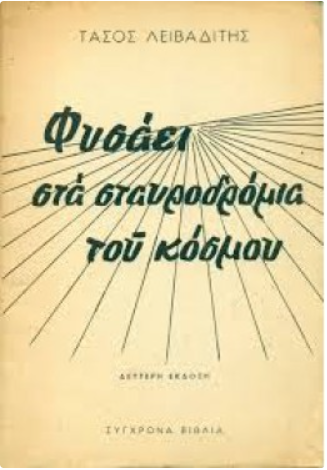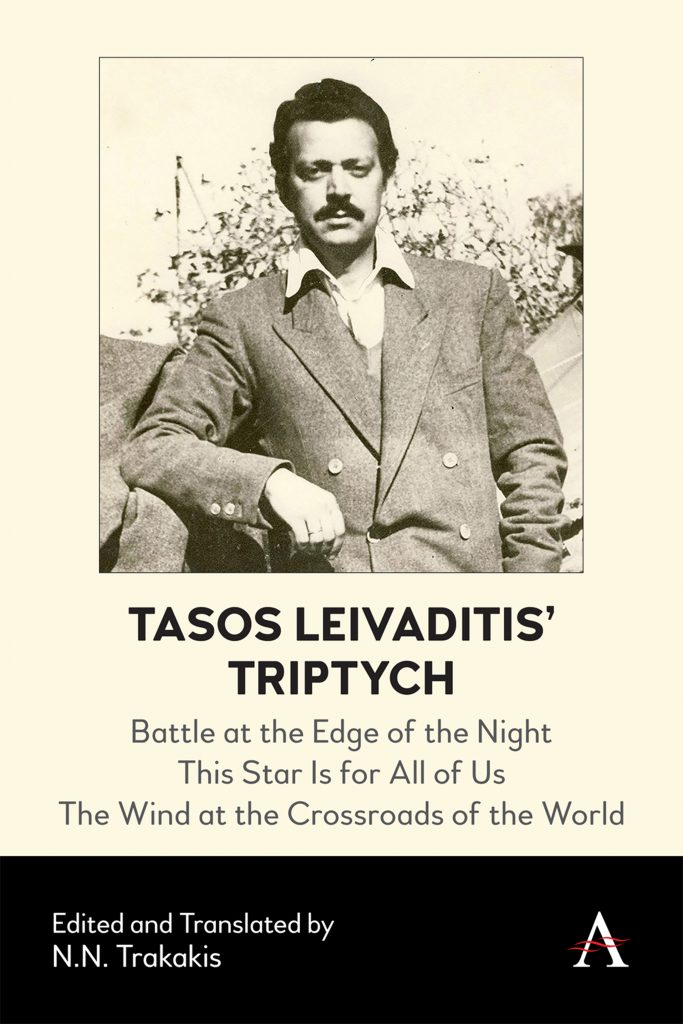Why I wrote this book by Ben Braber, Honorary Research Fellow, University of Glasgow; author of the forthcoming book Individuals and Small Groups in Jewish Resistance to the Holocaust: A Case Study of a Young Couple and their Friends He…
Month: March 2022
Tasos Leivaditis’ Triptych: Battle at the Edge of the Night, This Star Is for All of Us, The Wind at the Crossroads of the World
Q1. Who was Tasos Leivaditis?
Tasos Leivaditis was a modern Greek poet, short story writer and literary critic who continues to be widely read and loved in Greece, especially amongst the youth. He was born in Athens in 1922, and in fact lived nearly all his life in the capital city. His childhood was cheerful and carefree: a dreamer rather than a diligent student, he enjoyed music and poetry from an early age, and was even nicknamed ‘Lord Byron’ and ‘Leopardi’ at school. But it would be the encounter with communism in his early teens that would leave the most lasting mark on his life. He put his politics into practice during WWII, abandoning his law degree and supporting the leftist-led resistance to the Axis occupation. His support of the communist cause during Greece’s bloody civil war was to land him in serious trouble: he was arrested in 1948 and, without trial, sent to various detention centres in the Aegean, including the infamously brutal Makronisos. After more than three years in detention he was released and soon after he published in quick succession his first books of poetry, now presented in English for the first time by Anthem Press. This Triptych was enthusiastically received by critics as the work of an original, authentic, daring and passionate voice, even though it was to land its author in prison again for its allegedly subversive content. Leivaditis went on to publish a total of twenty volumes of poetry, winning along the way Greece’s highest honour in poetry (the State Poetry Prize, in 1979), and accorded in 1988 a state funeral after passing away at the age of 66.
Photo of Tasos Leivaditis:

Q2. What led you to translate Leivaditis?
The short answer is that I fell in love with Leivaditis’ work. (As a general rule, one should only translate what one deeply loves.) And when I discovered that Leivaditis had not been translated into English, I made it my mission to make his work available to English readers. I already knew he was greatly admired in Greece, and I suspected that this vital bond between Leivaditis and his countryfolk could be replicated in different contexts, even amongst readers without much experience or awareness of Leivaditis’ troubled times. My suspicion has thus far been confirmed. English readers tend to have the same reaction to Leivaditis as I had when I encountered him in the Greek original. A friend, upon reading Leivaditis for the first time in one of my translations, expressed what he felt and found with a single, perfectly chosen, word: devastating.
Photo of cover of original Greek edition of The Wind at the Crossroads of the World:
Q3. What were Leivaditis’ major influences and sources of inspiration?
Leivaditis was influenced by various intellectual and artistic currents, including literary trends that emerged in Greece in the interwar period such as decadence (typified by the disenchanted, anti-heroic poetry of Kostas Karyotakis, who committed suicide in 1928, aged thirty-one) and surrealism (introduced in Greece by Andreas Embeirikos in the mid-1930s). Leivaditis also drew upon more traditional sources, such as folk songs and the liturgy of the Orthodox Church. His poetic works, furthermore, interwove stylistic and structural features from other artistic forms, especially the theatre and cinema (his eldest brother, Alekos, was a famous actor) and music, both classical and popular (his many songs, set to music by acclaimed composers like Mikis Theodorakis, remain crowd favourites today). But there is no doubt that the most significant influence on Leivaditis’ work, especially the early work as represented by the Triptych, was communism. Earlier generations of Greek writers had already turned to Marxism: Kazantzakis, for example, joined the communist cause in the wake of the Asia Minor disaster, in 1922 (the year of Leivaditis’ birth). But it would be the wide-ranging poetry and socialist philosophy of Leivaditis’ lifelong friend, Yannis Ritsos (1909-1990), which provided Leivaditis with a model of how to combine a lyrical and romantic sensibility with a commitment to freedom and justice.
Photo of Yannis Ritsos:

Q4. Do you think the three works that form the Triptych have stood the test of time? What relevance do these works have for today’s readers?
Unfortunately, some seventy years later, Leivaditis’ Triptych hasn’t lost any of its relevance. I say ‘unfortunately’ because one would have liked greater progress to have been made on the central problems tackled in Leivaditis’ work, relating to freedom, justice, peace, and equality. In the early 1950s, when the Triptych originally appeared, the world was riven by the Cold War: the Korean war erupted in 1950; that same year, in my home country of Australia, prime minister Robert Menzies banned the Communist Party; in 1953 the Rosenbergs were executed in the US on espionage charges; in 1955 the Soviet Union set up the Warsaw Pact in response to West Germany’s admission to NATO. All this against the background of a potentially catastrophic nuclear arms race. These global conflicts were mirrored in Leivaditis’ Greece, where the divisions of the civil war (1946-49) continued well into the 1950s as anti- communism became legalised and institutionalised. One of its most feared institutions were the concentration camps spread across the Aegean islands, and it was here that Leivaditis wrote the first drafts of his Triptych. In the inhumane conditions of camps like Makronisos, where inmates were beaten and brutalised, if not murdered, for their communist allegiances, Leivaditis never gave up believing that “The sun is for all people./The day is near.//We will go on.” (from the conclusion to Battle at the Edge of the Night) Leivaditis’ defiant hope and unyielding resistance continue to speak to us, because domination and oppression, the gulags and camps remain with us, whether they be in Xinjiang, western China, or Putin’s police state, or the Pacific islands and Park Hotel in Melbourne, where refugees languish for years, detained and degraded, under our watch.
War and Peace in the Worlds of Rudolf H. Sauter: A Cultural History of a Creative Life | Q & A with Jeffrey S. Reznick
1 . What is the reason behind the interest in Sauter’s creative life? I became interested in the creative life of Rudolf H. Sauter (1895-1977) while I was completing research for my 2009 book about his famous uncle, the novelist…


